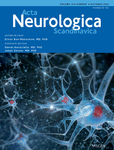Impaired neck motor control in chronic whiplash and tension-type headache
Funding information
Funding within institutions, no external funding
Abstract
Objectives
The purpose of this study is twofold, first to present a new method based on head laser tracking designed to measure head or hand movements and second to further investigate if patients suffering from chronic whiplash or tension-type headache have impaired motor control of neck muscles.
Material and Methods
A new laser tracking instrument was designed to measure the ability of a test person to track a reference point moving on the wall by a laser fixed to the forehead or held in the hand. The reference point to be tracked moves in runs of a circle or a square at three different speeds 10, 20, or 30 cm/s. We used a 1 × 1 ×1 m setup geometry to provide head movements well below pain release. Groups of 22 patients diagnosed with chronic whiplash-associated disorder grade 2, 19 patients diagnosed with chronic tension-type headache, and 37 control persons were compared.
Results
A small but highly significant dyscoordination of head movements was observed in both patient groups and in whiplash also of the hand.
Conclusions
Our study presents a new method based on laser tracking for precision quantitative measurements of head or hand movements during standardized conditions. The results confirm that motor control of head movements is impaired in both chronic whiplash and tension-type headache, and in whiplash also of the hand. This suggests involvement of the central nervous system in the pathology of these diseases.
CONFLICT OF INTEREST
None declared.
Open Research
DATA AVAILABILITY STATEMENT
Data are stored on the computer as part of the laser tracking instrument and are available from the corresponding author.




